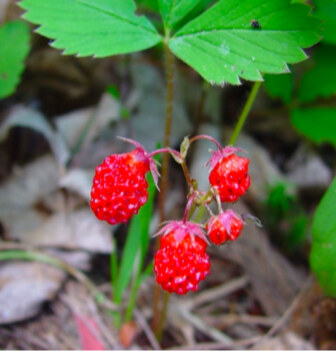Fragaria virginiana and Fragaria vesca
Download info sheetStrawberries belong to the Rosaceae family.
Identification & Cultivation: Fragaria virginiana is the wild strawberry indigenous to North America; Fragaria vesca is the wild strawberry or alpine strawberry  Fragaria vesca: illustration from ‘Atlas des plantes de France’ 1891, by A. Masclef)indigenous to Europe and North America. There is a white-fruited form, Fragaria vesca var. alba, (good to grow, as the birds don’t recognise the creamy-white berries, so they leave them alone). The species that is most commonly grown commercially and in our gardens is Fragaria × ananassa and its many hybrids.
Fragaria vesca: illustration from ‘Atlas des plantes de France’ 1891, by A. Masclef)indigenous to Europe and North America. There is a white-fruited form, Fragaria vesca var. alba, (good to grow, as the birds don’t recognise the creamy-white berries, so they leave them alone). The species that is most commonly grown commercially and in our gardens is Fragaria × ananassa and its many hybrids.
This is a perennial herb, which multiplies predominantly by sending out stolons or runners, spreading to make clumps throughout an area. Its most vigorous growth is in spring – sometimes dying back/becoming dormant as summer heat sets in. It prefers well-drained situations, with rich, loamy, free-draining soil, often near the edge of woods but also common in yards/roadsides. There are more than 20 different species ofstrawberries, and many more varieties.
Leaves: Trifoliate (in three parts), coarsely toothed, grow on a long, hairy stalk from a central location. The group of three leaves is usually 50-70cm across, each leaflet approximately 20-30cm in length.
Flowers: From late spring through to early summer; each flower being white, with five white, round petals surrounding a yellow centre.
Berries: The flowers mature into small red fruit – like a miniature strawberry – sweet and tasty, typically between 1-2cm across and heart-shaped. Technically it’s an aggregate accessory fruit – meaning the fleshy part isn’t derived from the plant’s ovaries but instead from the receptacle that holds the ovaries. Each ‘seed’ (on the outside of the fruit) is actually one of the ovaries of the flower, with a seed inside it. Fragaria virginiana Credit: Arthur Haines
Fragaria virginiana Credit: Arthur Haines
Parts Used: Pick the fruit when ripe (before the birds get them). Leaves are harvested in summer and dried for later use. Roots are harvested in autumn and dried for later use.
Constituents: The berries are a ‘superfood’, high in Vitamin C, thiamine, riboflavin, niacin, pantothenic acid, vitamin B6, folate, vitamins B12, A and E, and 18 different amino acids. Minerals in descending amounts: potassium, phosphorus, calcium, magnesium, sodium, iron, manganese, zinc, copper, selenium. Strawberries are over 90% water, 7% carbohydrates, 2% fibre and less than 1% protein, fat and ash; assessed to be in the top 20 fruits for antioxidant activity.
Uses: As food and medicine: Nearly every American Indian tribe had medicinal uses for the whole plant.
Medicinally: Leaves and fruit are mildly astringent, diuretic, laxative and tonic. The roots are astringent and diuretic.
Berries: Heart-shaped indicating a use – they protect the heart, increase HDL (good cholesterol), lower blood pressure and are protective against cancer. They can soothe an upset stomach. Rich in iron and potassium, it is a good food for those with anaemia. Fisetin, a naturally occurring flavonoid (abundant in strawberries, less in other fruit and vegetables), lessens complications of diabetes; in labs fisetin supported it to be neuroprotective; it promoted survival of neurons grown in culture and enhanced memory in healthy mice. An excellent food for when feverish, also effective in treating rheumatic gout, containing salicylic acid, makes them beneficial for treating liver and kidney complaints, gout and rheumatism.
Root: Decoctions soothe liver problems, staunch menstrual flow, firm the gums, help diarrhoea, chronic dysentery and chilblains. The root has been used as a coffee substitute in India.
Leaves: Fresh or dried, the leaves can be eaten or used as a tea substitute. As an infusion, it’s beneficial as a blood tonic, to treat diarrhoea, and, as has been used historically, fresh or dried leaves infused is used to dull the libido (an ananaphrodisiac).
External Uses: Sliced fruit can be used on sunburnt skin. The fruit has been used as a tooth cleaner; the fresh fruit removes stains if allowed to stay for approx. 5 minutes. The fruit can also be used in skincare creams; tones, whitens the skin, combats wrinkles, lightens freckles and soothes sunburn; mash some berries and spread over face as a ‘face pack’. Use as a footbath or wash as a treatment for chilblains. Dried and powdered leaves infused in oil can be used as a poultice for open sores.
Strawberry Vinegar
500g berries, 3 cups sugar,
3 3⁄4 cups vinegar (wine/apple cider vinegar)
Method
Place berries in a saucepan, just cover with water, simmer for 30 minutes, partially uncovered. Strain juice into pot/bowl (preferably overnight) – don’t squeeze or vinegar will lose its clarity. To the juice, add vinegar and sugar, stir over heat to dissolve. Bring to boil, simmer 10 minutes. Pour into sterilised bottles. A delicious ingredient to add to dressings, etc. A bit like a balsamic. This recipe can be made using other fruit, e.g. raspberries, mulberries, cherries, blueberries…
Cautions & Contraindications: Some people are allergic to eating strawberries. Symptoms include an oral allergy, including a rash around the mouth, dermatitis, hives or a hayfever-type reaction.
References: www.commonsensehome.com/wild-strawberry
www.greenmedinfo.com/blog/unheralded-strawberry-finally-getting-attention
Prepared by Jenny Ager-Pratt, Katikati Herb Society, for the Herb Federation of New Zealand’s Herb Awareness Week 2019.
Advisory Note: This text is given a general guidance. If any adverse reactions occur or symptoms persist, please contact a qualified medical herbalist or medical doctor immediately.

